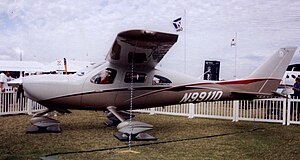Cessna NGP
| Next Generation Propeller | |
|---|---|
 The Cessna NGP prototype on display at Lakeland, Florida, in April 2007 | |
| General information | |
| Type | Proof-of-conceptdesign |
| Manufacturer | Cessna |
| Status | Dormant |
| Number built | 1 |
| History | |
| First flight | June 23, 2006 |
TheCessna Next Generation Propeller[1]Aircraft (NGP) was aproof-of-conceptdesign for a future family of singleengine,fixed-gear,highcantileverwing, light aircraft intended for personal,flight trainingand commercial use.
The single flyingprototype,registered N99110, was flight tested byCessna,and first seen publicly in flight on 24 July 2006 atEAA AirVenture Oshkosh.
Nomenclature
[edit]The aircraft was originally introduced as the "Next Generation Piston", but starting in April 2008 Cessna began referring to it as the "Next Generation Propeller" aircraft instead. After absorbing the recently purchasedColumbia Aircraftline, now known as theCessna 350andCessna 400,Cessna indicated that it was re-positioning the NGP to fit logically into its current aircraft fleet. "Our team is working on finalizing the configuration," said Van Abel, Cessna's project engineer for the NGP in April 2008. “We continue to evaluate features and materials that will produce a new, unique aircraft family with a potential for multiple powerplants.” This indicates that the aircraft may become turbine or diesel powered so as not to conflict with sales of the 350 and 400.[1]
Design and development
[edit]Very little information was made public about the aircraft since development began sometime in early 2005. Cessna confirmed that the NGP was designed specifically to compete with other, newer aircraft. Due to its intended role as competition for theCirrus SR22,it was frequently referred to in the aviation press as the "Cirrus Killer".
The NGPmock-updisplayed atAOPAAir Expo 2006, inPalm Springs, California,had five seats. The aircraft was, at that time, intended be powered by aLycoming IO-580FADEC320 hp (240 kW) engine controlled by a single power lever. The design mock-up had four doors with a separate baggage door on the left side,tricycle landing gearwith acasteringnose wheel and a forward-swept high-mounted wing of relatively small area.
Reportedly the prototype accumulated more than 20 hours of flying time between its first flight on 23 June 2006 and the fly-by at Oshkosh on 24 July 2006. During its appearance at AirVenture it was fully painted in a factory-style paint scheme and sportedwheel pants.The structure was made fromcomposite materialsandaluminum,optimizing the available technology.
Cessna President andCEOJack Peltonconfirmed at AirVenture 2006 that the NGP was intended at that time to be the first of a new family of Cessna singles that would, in the long term, replace theCessna 172and182in production. Pelton also confirmed that while the prototype flew with a Lycoming powerplant, Cessna was examining alternative new technology engines as well. The prototype was exhibited at the April 2007Sun 'n Fungeneral aviation event held atLakeland, Florida.
On 27 November 2007, Cessna purchased Columbia Aircraft from bankruptcy forUS$26.4M including its Columbia 350 and 400 line, which are in the same size and performance class as the NGP. These were introduced into the Cessna line as theCessna 350andCessna 400and initially built at former Columbia factory inBend, Oregon.In 2009, Cessna closed the Bend plant and moved production to Wichita. The introduction of the similar Columbia designs caused media speculation that this would spell the end of the NGP project, but on September 26, 2007, Cessna Vice President for Sales, Roger Whyte confirmed that development of the Cessna NGP project was continuing, regardless of the purchase of Columbia.[2][3][4][5][6][7]
In January 2009, Cessna CEO Jack Pelton gave an update on current Cessna projects under development and mentioned the162 SkyCatcher,Cessna Citation Columbusand theCitation CJ4.No mention of the NGP project was made and the project's webpage was deleted.[8]
On 30 March 2011, atSun 'n FunCessna President Jack Pelton was interviewed by Paul Bertorelli ofAvWebabout the NGP project and he indicated that it was "inactive but not mothballed" at that time, awaiting the right engine and avionics combination.[9]
By August 2011, the prototype was no longer on theFederal Aviation Administrationregistry.[10]
Specifications
[edit]| Thisaircraftarticle is missing some (or all) of itsspecifications.If you have a source, you can help Wikipedia byadding them. |
See also
[edit]Related development
Aircraft of comparable role, configuration, and era
Citations
[edit]- ^abGrady, Mary (April 2008)."Cessna Hints At Change In NGP Project".RetrievedApril 9,2008.
- ^Russ Niles (September 22, 2007)."Cessna Reportedly Interested in Columbia".RetrievedSeptember 24,2007.
- ^AvWeb (September 24, 2007)."Cessna-Columbia Deal Confirmed; Cirrus Says That's a Good Thing".Archived fromthe originalon October 17, 2007.RetrievedSeptember 25,2007.
- ^Textron (November 2007)."Textron's Cessna Aircraft Company to Acquire Assets of Columbia Aircraft".Archived fromthe originalon July 12, 2012.RetrievedNovember 28,2007.
- ^Russ Niles (November 27, 2007)."Cessna Gets Columbia".RetrievedNovember 29,2007.
- ^Grady, Mary (April 2009)."Cessna Will Suspend Columbus Program, Close Bend Factory".RetrievedApril 30,2009.
- ^AvWeb (September 26, 2007)."A Low-Wing Cessna Single? Cessna's Roger Whyte Explains Why It Makes Sense".Archived fromthe originalon December 2, 2007.RetrievedOctober 1,2007.
- ^Grady, Mary (January 2009)."Cessna Reports Progress On New Aircraft".RetrievedJanuary 15,2009.
- ^Bertorelli, Paul (April 2011)."Podcast: Pelton on the New Corvalis".RetrievedApril 5,2011.
- ^Federal Aviation Administration(August 2011)."Make / Model Inquiry Results".Archived fromthe originalon September 16, 2012.RetrievedAugust 1,2011.
References
[edit]- Avweb article on the NGP
- EAA's coverage of the aircraft's unveiling
- Cirrus SR22 performance parameters
- Cirrus SR22 pricing information
- Benenson, Tom, (Editor),FlyingMagazine, Oct 2006, pg 21,NGP Means "Next Generation Piston"
- Cessna press release announcing the NGP- accessed 16 October 2006
